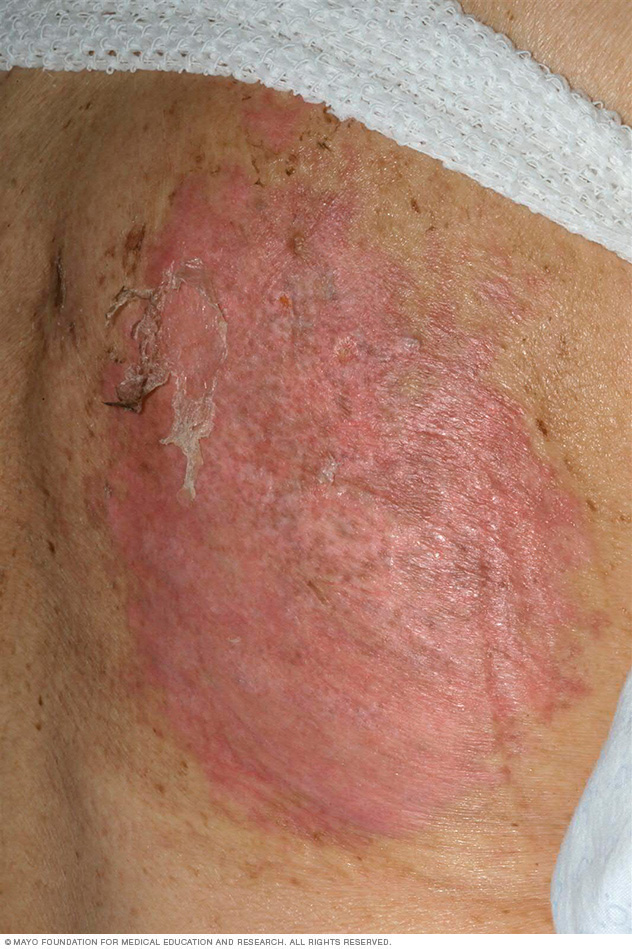Overview
Toxic epidermal necrolysis (TEN) is a rare, life-threatening skin reaction, usually caused by a medication. It's a severe form of Stevens-Johnson syndrome (SJS). In people with SJS, TEN is diagnosed when more than 30% of the skin surface is affected and the moist linings of the body (mucous membranes) have extensive damage.
TEN is a life-threatening condition that affects people of all ages. TEN is usually treated in a hospital. While the skin heals, supportive care includes controlling pain, caring for wounds and making sure you're getting enough fluids. Recovery can take weeks to months.
If your condition was caused by a medication, you'll need to permanently avoid that drug and those related to it.
 TEN causes large areas of blistering, peeling skin." />
TEN causes large areas of blistering, peeling skin." />Symptoms
Toxic epidermal necrolysis signs and symptoms include:
- Widespread skin pain
- A spreading rash covering more than 30% of the body
- Blisters and large areas of peeling skin
- Sores, swelling and crusting on the mucous membranes, including the mouth, eyes and vagina
When to see a doctor
Early treatment is key for people with Stevens-Johnson syndrome/toxic epidermal necrolysis (SJS/TEN). If you have symptoms, seek immediate medical attention. You'll likely need care from a skin specialist (dermatologist) and other experts in a hospital.
Causes
SJS/TEN is usually caused by a skin reaction to medicine. The symptoms are likely to start showing up one to four weeks after you start taking a new drug.
The most common drug triggers of SJS/TEN include antibiotics, epilepsy drugs, sulfa drugs and allopurinol (Aloprim, Zyloprim).
Risk factors
Factors that increase your risk of SJS/TEN include:
- HIV infection. Among people with HIV, the incidence of SJS/TEN is about 100 times greater than that among the general population.
- A weakened immune system. The immune system can be affected by an organ transplant, HIV/AIDS and autoimmune diseases.
- Cancer. People with cancer, especially blood cancers (hematologic malignancies), are at increased risk of SJS/TEN.
- A history of SJS/TEN. If you've had a medication-related form of this condition, you are at risk of a recurrence if you use that drug again.
- A family history of SJS/TEN. If a first-degree relative, such as a parent or sibling, has had SJS/TEN, you may be more susceptible to developing it too.
- Genetic factors. Having certain genetic variations puts you at increased risk of SJS/TEN, especially if you're also taking drugs for seizures, gout or mental illness.
Complications
People at highest risk of TEN complications are those over age 70 and those who have liver cirrhosis or spreading (metastatic) cancer. Complications of TEN include:
- Blood infection (sepsis). Sepsis occurs when bacteria from an infection enter your bloodstream and spread throughout your body. Sepsis is a rapidly progressing, life-threatening condition that can cause shock and organ failure.
- Lung involvement. This can cause coughing, difficulty breathing and, with severe disease, acute respiratory failure.
- Visual impairment. TEN can cause eye problems, such as dry eye, ingrown eyelashes, corneal scarring and, rarely, blindness.
- Permanent skin damage. After recovering from TEN, your skin may have bumps, scars and discoloration. Lasting skin problems might cause your hair to fall out, and your fingernails and toenails might not grow normally.
- Vaginal sores. In women, TEN can cause sores in the tissues lining the vagina, leading to pain or, if left untreated, vaginal fusion.
- Emotional distress. This condition causes distress and can have long-term psychological impact.
Prevention
To prevent another episode of TEN, learn whether it was caused by a medicine. If so, never take that medicine or anything similar again. A recurrence could be worse and life-threatening. Also tell any future health care providers about your history of TEN, and wear a medic alert bracelet or necklace with information about your condition. Or carry an allergy passport.
Diagnosis
TEN is diagnosed when people with SJS develop severe disease that affects more than 30% of the body.
Treatment
If your doctor suspects that your TEN was caused medicine you took, you'll need to stop taking that drug. Then you'll likely be moved to a hospital for treatment, possibly in its burn center or intensive care unit. Full recovery can take several months.
Supportive care
The main treatment for TEN is trying to make you as comfortable as possible while your skin heals. You'll receive this supportive care while in the hospital. It might include:
- Fluid replacement and nutrition. Because skin loss can result in loss of fluid from the body, it's vital to replace fluids and electrolytes. You might receive fluids and nutrients through a tube inserted in the nose and guided to the stomach (nasogastric tube).
- Wound care. Your health care team might gently cleanse the affected skin and apply special dressings infused with petroleum jelly (Vaseline) or medication. Your care team also monitors you for infection and gives you antibiotics if needed.
- Breathing help. You might need tests and procedures to evaluate your airway and help keep it clear. With advanced disease, you might need intubation or mechanical breathing assistance (ventilation).
- Pain control. You'll receive pain medicine to reduce your discomfort. For pain in your mouth, you might be given a mouthwash containing a numbing agent, such as lidocaine.
- Eye care. For mild eye symptoms, you might benefit from applying preservative-free artificial tears at least four times a day. Eye drops with corticosteroids might be used to control eye inflammation. Your care team might include an eye specialist (ophthalmologist).
Medications
Treatment of TEN also might include one or a combination of medications that affect the whole body (systemic drugs), such as cyclosporine (Neoral, Sandimmune), etanercept (Enbrel) and intravenous immunoglobulin (IVIG). Further study is needed to determine their benefit, if any.
© 1998-2025 Mayo Foundation for Medical Education and Research (MFMER). All rights reserved. Terms of Use


